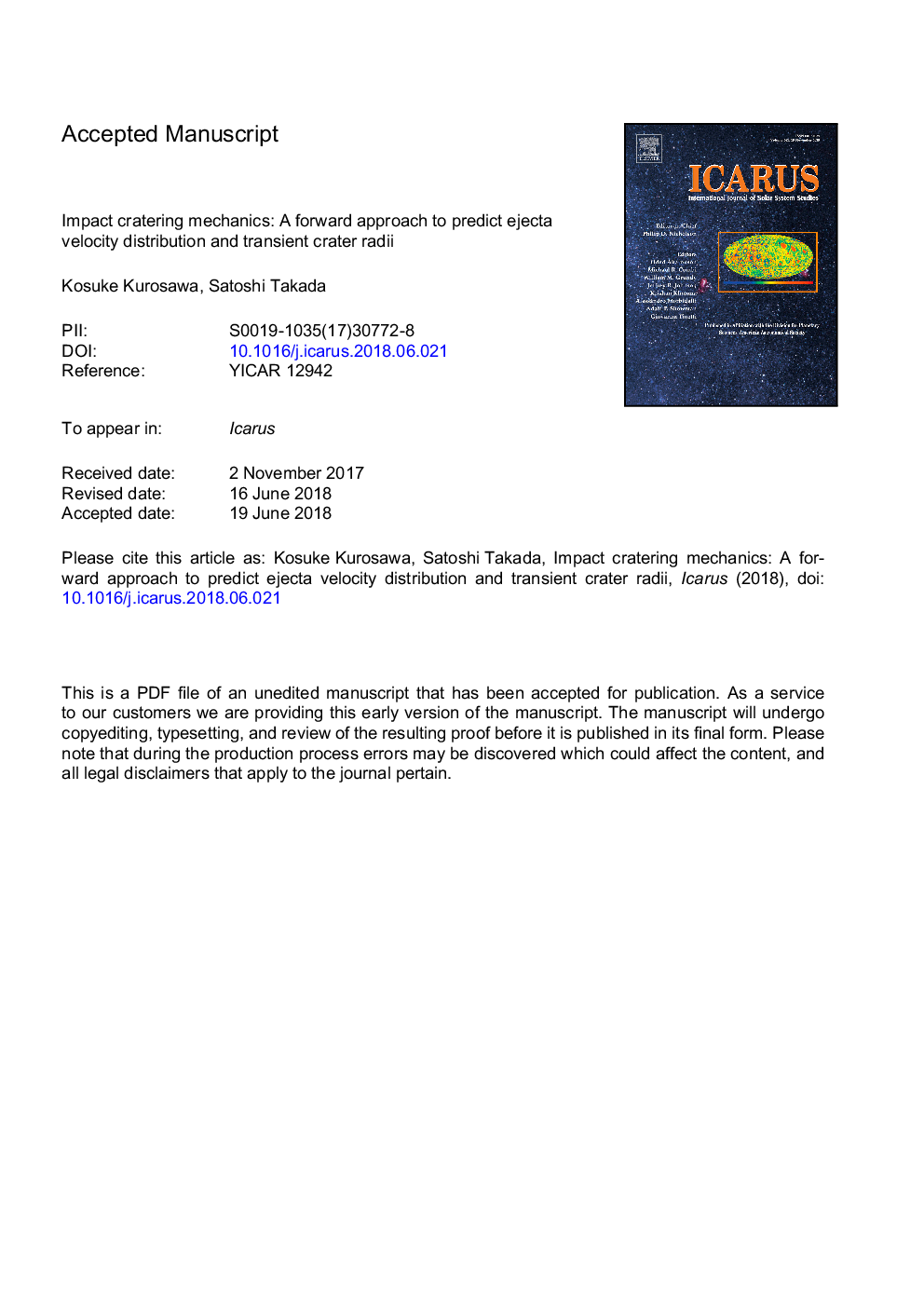| کد مقاله | کد نشریه | سال انتشار | مقاله انگلیسی | نسخه تمام متن |
|---|---|---|---|---|
| 8133662 | 1523475 | 2019 | 60 صفحه PDF | دانلود رایگان |
عنوان انگلیسی مقاله ISI
Impact cratering mechanics: A forward approach to predicting ejecta velocity distribution and transient crater radii
دانلود مقاله + سفارش ترجمه
دانلود مقاله ISI انگلیسی
رایگان برای ایرانیان
کلمات کلیدی
موضوعات مرتبط
مهندسی و علوم پایه
علوم زمین و سیارات
علوم فضا و نجوم
پیش نمایش صفحه اول مقاله

چکیده انگلیسی
Impact craters are among the most prominent topographic features on planetary bodies. Crater scaling laws allow us to extract information about the impact histories on the host bodies. The Ï-group scaling laws (e.g., Holsaplle and Schmidt, 1982) have been constructed based on the point-source approximation, dimensional analysis, and the results from laboratory and numerical impact experiments. Recent laboratory and numerical impact experiments, however, demonstrated that the scaling parameters themselves exhibits complex behavior against the change in the impact conditions and target properties. Since impact experiments are expensive and time-consuming in terms of obtaining new scaling constants, it is not feasible to explore the entire parameter space via experiments. Here, we propose an alternative, fully analytical method to predict impact outcomes, including the ejection velocity distribution and transient crater radii, based on impact cratering mechanics. This approach is based on the Maxwell Z-model (Maxwell, 1977) and the residual velocity (Melosh, 1985). Given that the shapes of the streamlines of the excavation flow and the kinetic energy in a given streamtube are known, we can calculate the ejecta velocity distribution and investigate the cessation of crater growth. We present analytical expressions of (1) the proportionality relation between the ejection velocity and the ejection position, (2) the radius of a growing crater as a function of time, and (3) the transient crater radii in the gravity- and strength-dominated regimes. Since we focused on obtaining analytical solutions in this study, a number of simplifications are employed, such as a priori assumption of the direction of the velocity vectors of the excavating materials, the neglect of the effects of dry friction, metal-like targets with a constant yield strength. Due to the simplifications in the strength model, the accuracy of the prediction in the strength-dominated cratering regime is relatively low. Our model reproduces the power-law behavior of the ejecta velocity distribution and the approximate time variation of a growing crater predicted by Ï-group scaling laws. In our model, the transient crater radius depends strongly on the shape exponent Z, the shock decay exponent n, and the exponent m pertaining to the residual velocity. Thus, the nature of shock propagation and the thermodynamic response of the shocked media, which cannot be addressed by dimensional analyses as a matter of principle, are naturally included in our estimation. The predicted radii under typical impact conditions mostly converge to a region between the two typical scaling lines for dry and wet sands predicted by the Ï-group scaling laws, strongly supporting the notion that the new method is one of the simplest ways to predict impact outcomes, as it provides analytical solutions. Our model could serve as a quick-look tool to estimate the impact outcome under a given set of conditions, and it might provide new insights into the nature of impact excavation processes.
ناشر
Database: Elsevier - ScienceDirect (ساینس دایرکت)
Journal: Icarus - Volume 317, 1 January 2019, Pages 135-147
Journal: Icarus - Volume 317, 1 January 2019, Pages 135-147
نویسندگان
Kosuke Kurosawa, Satoshi Takada,